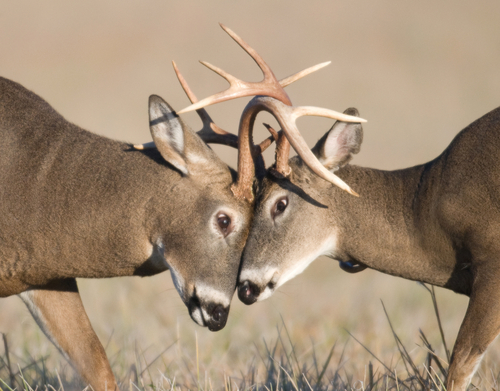
There’s a likely chance that you’ve had to slam on your brakes to avoid colliding with a deer, especially during this time of year. This populous species provides for an optimal hunting season for many while also making vehicle accidents and torn-up gardens a common occurrence. Looking beyond the scope of the issues they can cause, it’s easier to study their mating habits and overall behaviors than most other wild animals. One spectacular form of behavior by whitetail deer takes place during rut, also known as breeding season. Just like humans, deer have their own exclusive way to communicate or attract one another, and for them, this is done using whitetail deer rut calls.
Whitetail Deer Rut Calls and Interaction
Depending on the location, this season generally occurs beginning in early autumn and lasts through December. The shorter days with less sunlight cause an increase in hormones in the female deer, triggering rut. Females begin to become aggressive and intolerant and desire isolation. The doe will also push her fawns away, prohibiting them from drinking milk and attempting to seek isolation for herself. This not only prevents inbreeding between the mother and son, but also makes it easier for a buck to find a female.
A male’s testosterone levels are also amplified at this time of year, which increases tensions with other buck, as well as leads to an enlargement of their neck and sex organs. As this is occurring, a buck will wander outside of its home area in order to find a prized female. Both the actions of the female and the actions of the male occurring simultaneously make the rut season successful.
The actual event of breeding only happens over a two to four-day period during the female’s estrous cycle. Not only is this the specific time that a doe’s body is ready to mate, but there is also an increase in the amount of buck movement. A buck commences his search by checking in on any responses to his signposting. Signposting is when bucks utilize their glands by scraping and rubbing for the purpose of warning other bucks to keep their distance. A doe will respond to signposting activity by urinating near it. Once the buck picks up on the urine scent, he will attempt to find his doe. By smelling the urine, the buck can also determine if the doe is estrous or not. When doing this, he will curl his upper lip and raise his head, which opens the corridor to the vomeronasal organ that is designed to analyze urine and conclude whether or not the doe is estrous. Obviously if the doe is not estrous or close to it, the buck will ignore her.
Once a buck settles on a doe, he will begin to pursue her by making short dashes towards the doe along with short grunts and wheezing. In addition to the pursuit by the dominant buck, other subdominant bucks may join in the chase, which scientists believe triggers the estrous cycle. The doe will run away from the younger bucks and eventually only allow the dominant buck to approach her. The two will seek isolation and the buck will again analyze her urine. If indeed the doe is estrous, the buck will continue his pursuit in a more relaxed manner. He will elongate his neck and keep his head low. Sometimes bucks will act like this for an entire day, waiting for the doe to acquiesce. In a way, it’s the female’s way of ensuring that she will be mating with the strongest buck as younger bucks will become impatient and abandon the doe before she is ready to copulate.
Often, the buck will have to fight off other bucks while simultaneously protecting the doe. Unfortunately, the buck will also push away the fawns if they come too close to their mother at this time. If there happens to be a buck that does not respect the desires of the dominant buck, a fight will follow. The bucks will clash their antlers repeatedly until one comes out victorious, which is the one that will breed with the doe. Though these disagreements are usually short, they can cause severe injury to both, and can result in death if the antlers become locked. It’s also possible that the victorious buck will be too tired to breed, so another male may step or “trot” in to take advantage of the situation. It’s not often that buck fights occur as the dominance hierarchy is usually established and understood.
A doe will begin to urinate more frequently when she is nearing estrous. When she officially enters estrous, the doe and buck will breed – sometimes repeatedly. Once the buck becomes tired of her scent, he will abandon the doe and seek a new mate.
As the rut season comes to a close, hormone levels will decrease and deer will attempt to replenish their fat stores. Come spring, fawns will be born and the cycle will begin all over again. The breeding season of whitetail deer is a unique period of time for not only the deer, but also for the entire animal kingdom. There is an abundance of information known about deer behavior, which assists scientists, environmentalists, and hunters in a myriad of ways.
